Roger Moore
The 23 Best James Bond Films Of All Time
Science is well on the way to answering most of life’s great questions. Thankfully, science hasn’t yet found a way to take care of some of life’s more trivial matters, such as applying rigorous techniques to putting a series of motion pictures featuring the same central character into increasing order of quality, based on nothing more than personal preference. Whether he’s simply a violent, prurient escapist male fantasy taken to extremes, or actually the embodiment of everything desirable about popular culture wrapped up in a smart suit ordering cocktails, I’m still not quite sure after all this time, but at least watching all 23 films has enabled me to gain the gratification of ranking them into some sort of order.
Here is the list of all 23 official EON Bond films, in increasing order of competence. In case you are wondering, I loathe Casino Royale (1967) and Never Say Never Again, so they wouldn’t make a top 23 with a wider scope anyway. (Ha.)
23. A View To A Kill
Diamonds might be forever, but every Bond should know when it’s time to pack it in and hand over the Walther to the next fellow. AVTAK is a poor film in almost ever respect; Christopher Walken is weird but never menacing, Grace Jones is menacing but never sexy, Tanya Roberts is so anonymous her own family might struggle to recognise her and most of the rest is either old men toddling around the French countryside or one old man clambering about laboriously in various parts of California. We should all be relieved that this embarrassment didn’t kill the franchise stone dead.
22. Die Another Day
If this had actually been made as a cartoon, some people would still have griped over the lack of realism. Die Another Day sets itself up as a gritty, realistic take in the style of the films that followed it, then abandons that for abysmal CGI, charmless direction and a grating Madonna cameo. Your ears will feel abused listening to the Madonna song, not even the slightest fit for the opening credits, the bad guys are wet and their plan nonsensical and Halle Berry is less sexy here than she is in just about anything outside of Monster’s Ball. I have less of an issue with the invisible car than most people, but it’s still daft as a box of frogs.
21. Thunderball
Not so much bad as just eyeball-clenchingly dull, Sean Connery’s obvious ennui already after four films in four years and the unfortunate fact that Kevin McClory has to be involved after Ian Fleming handled their script badly doesn’t do anyone any favours. Sequences underwater which could have been exciting instead become interminable, and although it’s not one of the longer Bonds it certainly feels like it. The fact that Connery then signed up to the unofficial remake should make him and everyone else ashamed, and we can only be thankful that Kevin McClory’s passing spared any of the other Bonds a similar fate.
20. Octopussy
There are large stretches of Octopussy that are worse than anything in Thunderball, but it gets more credit with me for at least putting in some effort. The opening and closing airborne set-pieces are largely satisfying, Louis Jourdan is a suitably smarmy villain and the East German scenes do generate at least a modicum of tension. Roger Moore is by now in full-on arched eyebrow mode and Maud Adams is less effective here than she was in The Man With The Golden gun, but Octopussy isn’t a ride entirely without entertainment or intrigue.
19. Diamonds Are Forever
Anyone who thinks that the transformation of Bond into a more light-hearted, less ruthless entertainment vehicle rather than a cold-blooded killer who had any woman he wants started with Roger Moore obviously hasn’t watched Diamonds Are Forever in a while. It’s a Roger Moore type of film, and not a great one at that, in every sense other than its star, with yet another, increasingly uninteresting, version of Blofeld and Jill St. John’s brash, stroppy Bond girl being at time the cinematic equivalent of nails down a blackboard. The only real characters of interest, even if they are a sign of the times, are Mr. Wint and Mr. Kidd, but most of the rest is poorly handled and eminently forgettable.
18. Moonraker
Yes, it’s the one with the now infamous double-taking pigeon, but if you don’t mind it being an all-out romp that only exists because of Star Wars, then there’s reasonable amounts of fun to be had here. Bringing back Jaws is handled badly, turning him into a figure of fun and failing to gain sympathy, but the rest of the film never stands still long enough for its major flaws to become apparent. With a reasonable equal in Lois Chiles’ Bond girl and a decent villain from Michael Lonsdale, Moonraker is still the kind of Bond film to be reasonable Bank Holiday afternoon entertainment, but it’s about as far from Fleming’s vision as the series ever got.
17. Tomorrow Never Dies
Pierce Brosnan’s sophomore effort suffers slightly from never being quite sure what it wants to be. Michelle Yeoh gets to be dominant and agressive more often than sexy, which is a good match for Bond but isn’t compensated by Teri Hatcher’s flat portrayal of a woman Bond supposedly has a history with. (Of all the women he’s met, he’s coming back to this one?) The pre-credits sequence is a cracker, but the momentum of Goldeneye slowly dissipates after that, and Jonathan Pryce is at the bottom end of the Bond villain scale. There was a great movie to be made exploring tensions between the British and Chinese; this, sadly, isn’t it.
16. The Man With The Golden Gun
TMWTGG has one thing absolutely in its favour, a class act in the title role in the form of Ian Fleming’s step-cousin, Sir Christopher Lee. Whenever Lee’s on screen, the film instantly becomes more compelling, and it’s a shame he’s a peripheral figure for long stretches. There are other highlights, including (if you put your fingers in your ears) the spectacular bridge gap jump, but the more comedic approach that had started with Diamonds Are Forever really starts to take hold here, bringing back Sheriff J.W. Pepper for even more less comedic effect than in Live And Let Die and also playing the ending for laughs as well. A mixed bag, but by no means the worst Moore film of the series.
15. The World Is Not Enough
It all started so promisingly, with the boat chase along the Thames, Bond’s injury and subsequent cold shoulder from M and the early scenes with Elektra. Then about half way through we catch sight of Robert Carlyle attempting to be threatening from underneath a challenging look, but that’s nothing to the attempts (if you can call them that) to pass off Denise Richards as a nuclear physicist. Add more flailing from a poor decision to bring back Robbie Coltrane’s thickly accented Russian, and the second half of TWINE gets weighed down by its baggage. It was the first seeds of what Bond has become in the last decade, but those seeds were choked back by a few difficult weeds.
14. Quantum Of Solace
If I’m being completely honest, about 75% of what I love about Quantum Of Solace is Daniel Craig. I was one of the doubters before he first took the role but he’s nailed it so convincingly that even a film of at best middling quality, hamstrung by not enough rewrites from one striking writer and further on-set dabbling, can be elevated significantly by his performance. The first direct sequel of the series, it does make Casino Royale feel like a film of seven acts, as if someone had recognised it had Lord Of The Rings-levels of endings and lopped the last few off into a new film, but between Craig and Judi Dench’s increasing presence in the series as M, QoS does a lot to compensate for some of its more obvious flaws.
13. Licence To Kill
Don’t get me wrong, I love both of Timothy Dalton’s portrayals as Bond, but Licence To Kill is trying far too hard to be a generic American action film rather than a Bond movie – even down to Michael Kamen’s score and some of the desert settings that make it feel oddly like a British Lethal Weapon spin-off – and two weak Bond girls and some uncomfortable lurches in tone do Dalton no favours. It’s a shame this was to be his last entry, but having six years of breathing space actually did Bond a few favours, making this an odd post-script to the first great era of Bond.
12. Dr. No
You can tell I’m a humble blogger and not a practised, literate film critic, when the best description I can come up with of Dr No is “it’s all right”. I’m resolutely whelmed by Sean Connery’s first attempt at the role; it’s got some great moments, from the iconic casino introduction to the cold-blooded bedroom killing, but it never quite takes off, suffering now by comparison to the later films and suffering from hindsight rather than benefitting from it. It does have one of the better villains, and puts a decent number of the regular ingredients in place, but this was a good start, rather than classic Bond.
11. Live And Let Die
The first Roger Moore Bond, and the first to be heavily influenced by other factors in popular culture at the time (other than the general love of spies and secret agents in the Sixties, of course). Moore manages to avoid aping Connery, and Yaphet Kotto manages to overcome the identity shenanigans of the plot to put in a solid baddie. Solid just about sums up Live And Let Die, it’s never truly spectacular in terms of either action or characterisation but never disappoints, as long as your J.W. Pepper tolerance levels are reasonably high. Points also for what remains the best Bond theme to date; even Guns N’ Roses managed a decent cover version of it.
10. On Her Majesty’s Secret Service
Regarded by many as the best Bond, and it would undoubtedly have placed higher on my list if it had featured Sean Connery. Actually, it would have placed higher if it featured anyone who could act. Lazenby, having blagged his way into the role in the first place, does his best but frequently looks out of his depth and also helps contribute to a few saggy sections around the middle. The ending has had an impact on pretty much ever Bond made since, and Diana Rigg is undoubtedly one of, if not the, best Bond girls of all time. Sadly, Telly Savalas doesn’t quite work as Blofeld either, and we’re left with a great film with two holes of varying sizes at its centre, but you can see how it’s inspired the likes of Christopher Nolan on to great things.
9. For Your Eyes Only
The last of the three decent Moore Bonds, it would have been a fitting cap to his years in the role. As it is, FYEO is still an effective Bond movie with more weight to it than you’d expect. That’s undoubtedly down to the strong story and themes of revenge that motivate the characters, and even Lynn-Holly Johnson’s role as the annoying youngster with a crush on James doesn’t manage to unbalance the overall effect. The marked reaction to the spacefaring of Moonraker makes for a more grounded Bond, but there’s still cracking set pieces (especially the assault on the cliff top) and there’s a tension here that’s lacking in most of Moore’s other Bond films.
8. You Only Live Twice
Probably the most spoofed of all the Bond series, with likely the most iconic set of elements outside of Goldfinger. It’s not often that a production designer can become a household name, even if only among movie geeks, but Ken Adam’s work on You Only Live Twice helps to mark it out as one of the most memorable Bonds in a visual sense. The Japanese theme gives a different tone to proceedings and helps to mark time until the final, all out blow-out, the grandness of which even this epic series of films has sometimes found hard to top since. Roald Dahl’s script does recycle a couple of Bond staples and Connery’s not at his best, but these are minor distractions.
7. Goldeneye
For someone who seemed such a natural fit for the role and was connected with it for so long, it’s strange that there’s only one genuinely great Pierce Brosnan Bond film, and one in which he hadn’t totally nailed the demands of the role. Occasionally a little too cheesy, he still manages the required gravitas in more serious scenes and handles the mix of tones well. Where Goldeneye scores bonus points is for the Bond girls, the best in the roles in many years, with Isabella Scorupco’s feisty Russian finding Bond’s heart, and if you don’t enjoy Famke Janssen’s utterly over-the-top performance, you maybe need more joy in your life. (Especially her delivery of the line, “He’s going to derail the train!”) Tina Turner’s pounding title song helps ease the pain of Eric Serra’s excellent but completely inappropriate Bond score, and the fight between Sean Bean’s agent gone bad and Brosnan must rank in the top five fist fights of Bond.
6. The Living Daylights
Stepping in when Pierce suddenly found himself otherwise occupied, Timothy Dalton helps to resurrect the series from the worst excesses of the latter day Moore and gives a polished performance with dark undercurrents as Bond starts to steer back closer to Fleming’s original intent. The Living Daylights makes the most of the changing political landscape of the time, taking a plot based around various factions of Russian military power and bolting it to some superb action sequences, with one of the great car chases of the series and a truly insane stunt hanging out of the back of a cargo plane. Maryam D’Abo’s Bond girl is a bit wet at the best of times, but pretty much every other actor is on top form and director John Glen doesn’t waste the opportunity of finally having some decent material and a good Bond to work with. It’s a crying shame Dalton only got to make two, but at least we have this one to savour.
5. Skyfall
The latest Bond, in a fiftieth anniversary tale that paradoxically draws on the rich history of Bond and attempts to work once again with key elements, but in other ways is keen to put its past behind it and to find its new place in the world order. It’s a strange balancing act to even want to attempt, to be so in love with the past but in need of staying relevant for the future, but somehow Skyfall manages it, for the most part. Javier Bardem is 12A rating threatening, Dame Judi drops the first ever F-bomb of the series (and who’d have thought it would be her) and Bond gets to work closely with both Q and Tanner for the first time, in a surprisingly UK heavy set film. It’s a Bond film that looks gorgeous, is stunningly shot and calmly directed with both a sly wit and a general charm missing from Quantum Of Solace, but that never quite has the action beats to put it among the finest of the series and a plot that follows a recent blockbuster trend of relying too heavily on coincidence. If the remaining Daniel Craig Bonds can couple what’s great here with some of the finer action moments, then there’s still the potential for a best in series in Daniel Craig.
4. Goldfinger
For anyone that’s seen even a good selection of Bond films, the standard to beat is always felt to be Sean Connery’s third outing in the tux, and the first where some of the more outlandish elements of the series first came into play. From Shirley Bassey’s theme song to the Aston Martin DB5, and with the single most famous quote of any Bond film, Goldfinger feels like it should be the best Bond, so it feels somewhat heretical to pick at its flaws. But flaws do exist, not least in the saggy middle that so many Bonds seem to suffer and which also afflicts this one, and from occasionally feeling just a little too far over the top. Connery’s at his laconic best here, often a man of few words and smouldering glances but his reliance on almost supernatural powers of seduction rather than any serious amount of sleuthing leave Goldfinger as the silver standard of Bond movies, rather than the somewhat more appropriately-coloured one.
3. The Spy Who Loved Me
Two days ago, I saw a man outside a cinema pointing at a poster, attempting to encourage his very young son to take an interest in James Bond. I’m not sure Skyfall is the best entry point into the series, but mine was The Spy Who Loved Me and it still works as an excellent introduction, blending together most of the traditional Bond elements and beating just about any other Bond hands down for pure, old fashioned Saturday matinee-style entertainment. When Carly Simon sings “Nobody Does It Better”, it’s hard to disagree, as TSWLM succeeds in marrying You Only Live Twice-style excess to Goldfinger levels of Bond iconography and to make Roger Moore seem stylish and enviable. There’s not a single weak link, although it’s a shame that Jaws’ impact here is retrospectively lessened by his return in Moonraker. (Although when Carly Simon’s next line is, “but sometimes I wish someone could,” do you think she’s still pining for Connery? You’d think this would have cured her of that.)
2. Casino Royale
An all new Bond for a new era, and for the most part a Bond that wasn’t afraid to take chances. Martin Campbell might have returned to the director’s chair again after Goldeneye, but the reinvigoration he performed there is nothing compared to the kick up the backside the series gets here. Craig’s Bond can be brutal, almost thuggish at times, but also has the effortless charm of the best of his contemporaries, and in his pairing with Eva Green’s Vesper Lynd one of the greatest pairings of the series. Bond is damaged goods, and despite being a reboot of sorts (but still with Dame Judi in the top chair) Casino Royale wastes no time in damaging him a bit more. The swap to poker for the central card game works in the context of the film and the modern setting, as do so many of the other choices, the only real failing being a lumpen story structure that feels like it’s carrying an unwanted epilogue. Mads Mikkelsen’s ocularly challenged baddie threatens but never dominates, but the blend of all the elements – especially a number of truly breathtaking action sequences – is pretty much spot on.
1. From Russia With Love
If Goldfinger has turned out to be the stereotype that much of the series followed, and Dr. No remains the prototype, then sandwiched between them and often unfairly overlooked is the archetype for the Bond series. It’s as close as the Bond formula has ever come to being perfected, from the SPECTRE training base and the first glimpses of Blofeld to the stunning train face-off between Bond and Red Grant. Everything is as you’d want it in a Bond film without being taken to excess, and a number of series firsts (including Desmond Llewellyn’s first outing as the quartermaster and Matt Munro’s first song with the title of the film in it) helping to make the Bond formula that still exists today. The recent Bonds have steered closer and closer to this template without ever successfully emulating it, and if only Skyfall had been this successful at both plotting and also a triple whammy of an action finale that just doesn’t let up. The cool, calculating charm that attracts women and makes men just a little bit jealous is all rooted in Russia, and it’s the Bond film I love the most.
Bond Legacy: A View To A Kill

Finally, the end of the road, a Bond film for which even Roger Moore thought he was too old. He was, of course, quite right. Let’s not beat about the bush, A View To A Kill is awful.
What? You want more? Where to start. There are very few moments that A View To A Kill actually feels like a proper Bond film, except when it’s ticking off the occasional past legacy. But Rog is absolutely going through the motions at this point, and he’s going through them slowly and with some difficulty because he’s quite clearly past it. The rest of the cast resembles a freak show that would put Britain’s Got Talent to shame; Christopher Walken is in full on weird mode, but fails at any point to come over as threatening; whoever thought Grace Jones could act needs to be taken out and shot; and poor old Patrick Macnee looks like he’s stumbled in off the set of an entirely different film and is now being kept as Rog’s slave.
(A note on those old legacies, though: while I didn’t list it out originally, pretty much any Bond film with either a large set of henchmen or international investors gets them together and sits them round a table, and the cunning twist here is that the table has been set up in – an airship! What larks. It is the most Bond-like moment in the whole film, so thanks to whichever film did it first. [hurriedly scrambles back to start watching Sean Connery Bonds again])
If any of the action scenes redeemed it, it mightn’t be so bad, but there’s some Paris-based rumblings that are faintly ludicrous at best, and a chase on a fire engine that feels like a deleted scene from Herbie Rides Again rather than a main set piece in a Bond film. Almost no-one involved with the production has fond memories, and we should just be thankful that this finally convinced everyone it was time to put The Amazing Eyebrow out to pasture and get someone younger and better in. Given that much of the talent behind the camera, including the screenwriter and director, came back again next time, quite how they got it so badly wrong here all round when that can’t all be blamed on the practically octogenarian star is a matter that’s probably not worth expending much time contemplating, but is still somewhat strange.
Anyway, despite being as ripe as a six month old pear at the bottom of the fruit bowl, A View To A Kill still managed to show the power of the Bond brand by having a further legacy or four on the rest of the series.
1. It’s all in the game
A View To A Kill holds the distinction of being the first Bond film to be represented by a computer game. The likes of Goldeneye on the N64 were but ten years away at this point, but the fact that the Bond franchise has produced some high quality games and that one all time classic probably couldn’t have been guessed from the amazingly shoddy graphical adventure unfolding on the C64 and other comparable platforms. Still, we’ve all got to start somewhere. There was almost a game for Octopussy, but it was never actually released; the mind can barely grasp what 8-bit innuendos we’ve been denied by that decision.
2. It’s all in the family

Speaking of talent in front of and behind the camera, one of the most regular names to appear on Bond films is that of Michael G. Wilson. Having had a hand in writing every Eighties Bond, he’d also acted as an executive producer since Moonraker, but AVTAK marks the first time that Cubby’s stepson stepped up to join the big man as a fellow producer. When Barbara Broccoli then joined him on producing duties from Goldeneye, the family template was set and Wilson and Broccoli continue to steer the direction of the Bond series to this day. He’s also had cameos in a remarkable fourteen films of the series, making him the Stan Lee of the Bond movies. (Is it too late to get Stan? He’s ace. Oh, okay.)
3. Board of Bond?
Despite the stunts being mainly ropey, one of them turned out to become iconic after all, and it’s probably a moment that will send shudders down the spines of most Bond aficionados. Snowboarding, despite having been done for around 20 years, was still a niche sport, attracting no attention outside the hardcore skiing world until an old man’s unconvincing stunt double slid down a hill on a converted ironing board to the accompaniment of The Beach Boys. Thirteen years later, it was an Olympic sport. See, even the worst Bond films can be a force for good.
4. The name’s the thing
And just a final note on a legacy first mentioned in From Russia With Love. The tradition of naming the next Bond film in the end credits went slightly askew last time, when Octopussy predicted the next in the series would be called “From A View To A Kill”. Maybe in a sense of embarrassment at getting the title so shamefully wrong, A View To A Kill simply stated that “James Bond Will Return” and left it at that. Without even realising, the Broccolis had given an early indicator of the uncertain future the Bond films were about to start facing…
Next time: Come on, Tim! It’s The Living Daylights.
For more Bond related japes and in-depth analysis, visit BlogalongaBond.
Bond Legacy: Octopussy

So, the time has come. The time I’ve been dreading since we started BlogalongaBond all those months ago. If I had to pick one film that I thought would be a struggle in coming up with legacies – and I did – then it would have been this one. The name with the biggest innuendo in any Bond film title has a reputation that precedes it of being somewhat of a dog’s dinner of a film, and I didn’t have particularly fond memories of it from my childhood. But, for thirteen months, I’d lived in fear of coming to this, coming up empty handed and for the Bond Legacy dream of every Bond film leaving a mark.
In one sense, I needn’t have worried, for Octopussy does a fairly good job of helping to leave a lasting legacy that no-one likes Roger Moore James Bond films. The likes of The Spy Who Loved Me feel a distant memory whenever it comes to thinking of Roger Moore, as it’s this arse end of his overlong run of films that stick most in the memory nearly thirty years later. By any convention, Octopussy is a fairly desperate film, and it’s actually a relief that there wasn’t a new Bond for this one, as if he’d ended up with similar material it might have killed his career stone dead.
In terms of what actually works here, there’s the opening stunt with the Acrostar, which is part of a fairly efficient opening sequence, and the final plane stunt is also pretty reasonable. Moore’s not really doing anything different here than he has been previously, other than occasionally being even more lecherous than before, but it’s to Octopussy’s shame that his performance and the two book-ending stunts are about the only major positives to take from this one.
But actually, there are just a few tiny morsels to take away that show that even this dated mess has still had an influence on what followed. (That rushing air sound you can hear is me breathing a huge sigh of relief.)
1. The age of enlightenment? Not quite.
As I’ve mentioned before on this journey, Roger was older when he started than Connery was when he finished. 1983 is a significant year in the Bond world for another reason, and it’s mainly the reason that poor old Rog got dragged back for another round of lasciviousness and eyebrow raising. Shir Shean Connereh was 53, but was offered flipping great wodges of cash to make an unofficial Bond based on Thunderball whose title, I must remind you, we can never say. Never one to miss out on some cash himself, Roger was nearly persuaded to appear again in Sean’s film in a climactic scene, but in the end we just got Lord Connery of Sell-Out winking at the camera. Probably for the best, that dirty old winker.
Consequently, maths being what it is Roger was still older in 1983 than Sean was, and Roger had reached the ripe old age of 56 by the time of Octopussy. While he has, again due to maths, continued to get older since, Octopussy was the first time that Rog looked genuinely past it, yet with the application of plenty of soft focus, long range camerawork and unconvincing stuntmen it was possible for a man nearer sixty than fifty to still be an action hero. Arnold Schwarzenegger in Terminator 3? 56. Liam Neeson in Taken? 56. Bruce Willis when he started filming Die Hard 5? You guessed it, 56. If it hadn’t been for the desperate lure of lining their pockets with even more cash Roger’s heroic example, none of those would have been possible.
2. Always be careful what’s on the menu when sitting down to dinner in India
Of course, India is a third world country, and rather than the refined delights of foie gras, haggis and black pudding that would grace many fine dining menus in this country, in India all they eat is sheep’s head and monkey’s brains. Such an elegant menu deserved to be rolled out again for special occasions, as it was a year later in Indiana Jones And The Temple Of Doom. Is it wrong that I’d be prepared to give monkey brains a go?

3. Ever wondered why so many people think clowns are scary?

Next time: Old father time decides he’s had enough. It’s A View To A Kill.
For more Bond related japes and in-depth analysis, visit BlogalongaBond.
Bond Legacy: For Your Eyes Only
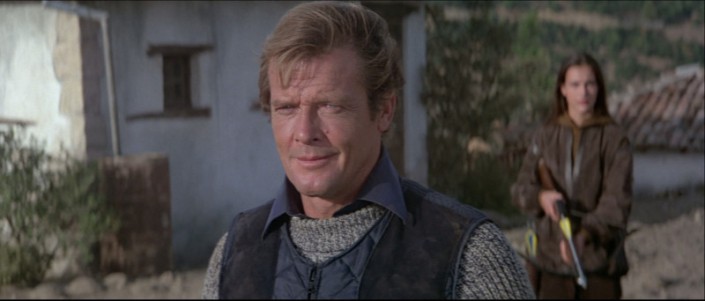
Is it really a whole year since we started rewatching Bond films? Twelve months, and a round dozen films, and we now reach the point of no return – less films ahead of us than behind. For many others on this journey, it will actually get easier as generally better perceived Bonds will get their turn and the films will improve after the early Eighties fallow period. For me, each film gets harder, as my theory that each film has a legacy has less time to actually come to pass and each individual legacy becomes that much harder to pin down.
I had consoled myself with the thought that at least there was one more watchable Roger Moore film to come, but I was completely unprepared for the start of For Your Eyes Only. The worst pre-credits sequence of the entire series, it’s laughably bad and makes most of Moonraker look a work of art in comparison. From the decision to bring back Blofeld and then turn him into a pantomime caricature, to the whistle as Bond drops him down a giant chimney (the worst sound effect in the series since The Man With The Golden Gun), it’s a start from which most Bond films would struggle to recover.
Yet, more in line with my expectations, FYEO pulls it off. Generally reverting to a more serious and realistic tone than Moonraker – apart from the should-be-laughable-but-it-actually-made-me-weep-tiny-tears Margaret Thatcher scene at the end – Roger Moore is once again on top form and just about belies his increasing age, for probably the last time in the series, thanks to extensive use of soft focus and lens vaseline (sadly, by the time of Octopussy, even that won’t be enough). There’s also a sensible distribution of Bond girls, and James sensibly draws the line at the shouty one with pigtails young enough to be his daughter.
It’s also one of the more MacGuffin based Bonds, with the ATAC machine offering a tangible distraction for both sides to get their hands on. It also sees a shifting in Anglo-Russian relations (those of you playing the Bond Legacy drinking game, take a swig now) with General Gogol firmly on the other side, rather than hovering shadily in the middle. There’s some decent, rather than spectacular, action sequences and it all slips down fairly easily, although it might be a little forgettable a couple of hours after you’ve watched it.
Thankfully there’s still a few legacies to be had, before it’s all destined to go horribly wrong next month.
1. Car chases can be as effective without the gadgets
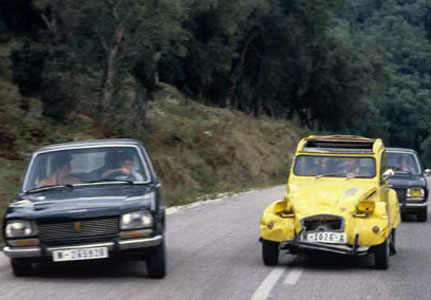
There might have been a variety of different cars or styles of driving over the past twenty years of Bond films, but generally Bond has been seen in quality motors, and even when he hasn’t – for example, The Man With The Golden Gun – the stunt has been spectacular enough or the rest of the driving mundane enough for it not to matter. But for the first time in the Bond series here, James is forced to make the best of a bad job, and works wonders with his Citroen 2CV, taking it off road even after Melina has managed to roll it trying to take a simple right turn. Women drivers, eh…
I’m sure Jason Bourne would like to think his various escapades in clapped out old bangers were showing a new or innovative side, a world away from the fast car sheen of the James Bond films, but Bond has proved here he can slum it with the best of them. One thing though; I’d have a word with Q about that ridiculously over-zealous anti-theft device if I were you, James.
2. The regeneration game
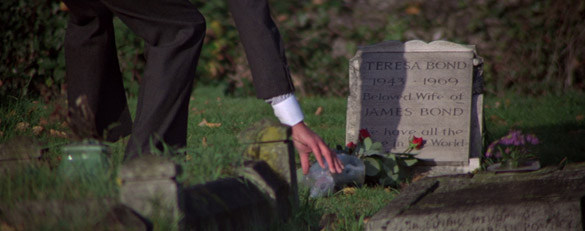
While the characters have always had the same names, the Bond series had never made it as explicitly clear about the continuity of the character as it does here. So Roger Moore’s Bond is definitely the same Bond as George Lazenby’s Bond, even though they look different. Well, either that, or they both happen to have a wife called Teresa who died in 1969. Which, presuming that both films took place in the current year, is twelve years ago. Unless this isn’t actually 1981, or the whole opening is some form of psychotic episode on Bond’s part, driven to twelve years of grief over the death of his wife.
Anyway, the films would make further allusions to the fact that Bond had lost a loved one in tragic circumstances, right up as far as The World Is Not Enough, so assuming Bond was the same age as Tracy in the films (which he almost certainly wasn’t), and that film is also contemporary, Pierce Brosnan would have been playing a character well into his fifties, for which he was looking remarkably good. Inspiring the hard men of the world, Jack Bauer (born 1966) would have been well into his fifties by the end of 24 if season 1 of that show was contemporary and the gaps between seasons were correct, and if John McClane was 31 or older in Die Hard – quite likely as he’d been a cop for 11 years at that point – it would put him into his sixth decade by the time of Die Hard 4.0, and certainly well past 50 by the time of the upcoming A Good Day To Die Hard. (And you thought Skyfall was a rubbish title.)
This, of course, was unceremoniously pissed all over when Daniel Craig turned up, rebooted the continuity but M looked exactly the same as she did for the last Bond, even though she was a different M – or had a sex change and lost a lot of weight – than the M that didn’t appear in For Your Eyes Only, because he’d sadly died. Unless this is all still George Lazenby having an extended psychotic episode; on reflection, that might be easier to believe…
3. And Connery begat Moore, and Moore begat Brosnan
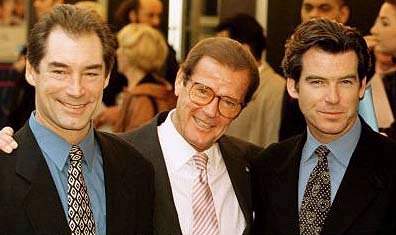
Speaking of Brosnan, the last legacy of this particular film was that it featured Cassandra Harris as Countess Lisl von Schlaf. Cassandra was also know as Mrs Pierce Brosnan, and hubby and Cubby met on set, whereupon Broccoli declared, “…if he can act… he’s my guy.” Fourteen years later, by which time Cubby was too infirm to work in any serious capacity on the series, he finally got his man. While it was Cassandra’s wish that her husband get the Bond job, sadly she died of cancer in 1991 and never saw him slip on the tux. Hopefully she would have been proud. Of Goldeneye, at least.
Next time: Go go Gadget innuendo. It’s Octopussy.
Bond Legacy: Moonraker
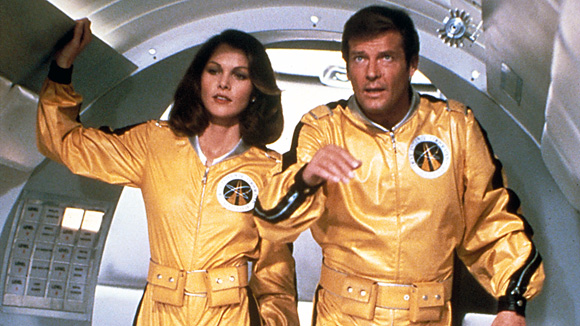
I knew this day would come eventually. The day when I would have to confront my deepest, darkest fear. The day when the truth would finally be revealed to me, when innocence would be stripped away and when some of the most treasured memories of my childhood would be held to close scrutiny, and may never be the same again. Yes, BlogalongaBond has finally reached Moonraker, and it’s time to face the facts: Moonraker was the first James Bond film I ever saw, and when I was a kid, it was my favourite Bond film.
I could sit here and make excuses, but when you think about it, Moonraker is the ideal Bond film for kids. Much of this is down to the direction that Jaws has been taken in, his seeming indestructibility taking the series past the point of self-parody to a point where nothing feels dangerous or serious any more. But it’s also ideal for those, like children, with short attention spans; forget the three act structure, you attempt to stitch a start, middle and end out of the plot and you’ll barely cover half the film. What’s painfully clear is that the film I enjoyed as a child leaves rather more to be desired as an adult.
Some of that is also down to Bond, and by that I mean the way he’s written as much as the way he’s performed. Roger Moore has the most famous arched eyebrow in movies, and here it’s in full effect. The script gives him plenty to react to, so Roger gets through a full range of expressions of surprise, from mild surprise to total astonishment with a side order of smug self-satisfaction to boot. But there’s also some issues around Bond’s competence; even if you have got a hang-glider in your boat, would you really drive headlong for a giant waterfall when you could just turn around and drive back the other way? And let’s not even talk about Bond’s repeated attempts to punch a man with giant metal dentures IN THE FACE.
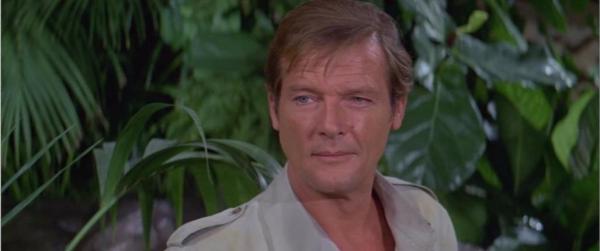
There are some good moments (the opening sky dive – up to the point where Jaws attempts to open his parachute – and the cable car fight – up to the point where Jaws attempts to stop the cable car – are notable), but there are also some strange moments, not least when Bond rocks up at a cross between Logan’s Run and a Miss World pageant and gets strangled by a giant snake. Thankfully, it’s not a total write-off; as well as bearing the questionable legacy of being the Bond film that got me into Bond films, there are a few lasting legacies from the, erm, (counts on fingers) eleventh Bond film.
1. Space travel will be a reality in my lifetime
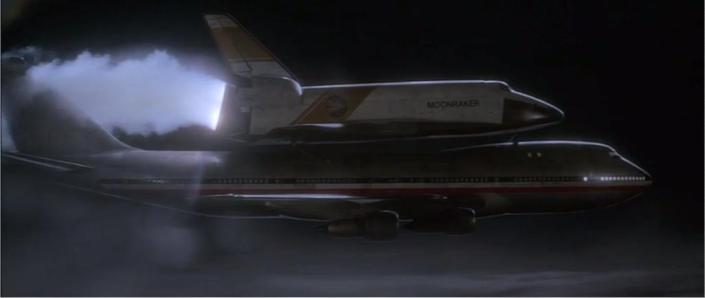
If I had to list my top three methods of vehicular mobilisation for our hero, then slots one and two would have an Aston Martin and a Lotus in them. Slot three, though, would be a space shuttle. (I had all three in my toy box under the sideboard when I was a kid; not real ones, of course – that would have been silly.)
Bond films have, especially more recently, wanted to be a reflection of modern technology and there’s no better example of the Bond movies being one step ahead of the real world than the use of the giant white space rockets. They’ve also given rise to the most unlikely trilogy in the world: The Space Shuttle Trilogy, consisting of Moonraker, Space Camp and Space Cowboys (all three of which would have been suitable titles for this film).
Sadly the space shuttles are no more, and their thirty year legacy has come to an end, and if I ever do get into space it’ll be in something a lot less classy – but if easySpace exists in my lifetime, I’m not proud.
2. Jaws 2: The Revenge
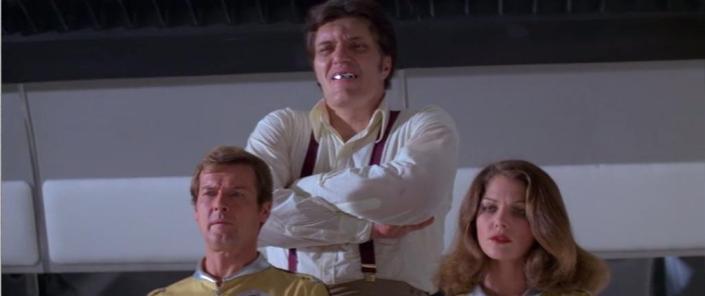
For the second time in the Seventies, a character made enough of an impact to be asked back again. (What’s this, Evangelist, I hear you cry? How can this be a legacy if it’s been done before?) I’ve already made reference to it, but Moonraker is the film that brought back a character, and in the process not only diminished the current film, but also unfairly tarnished the memory of the previous one as well. It’s now impossible to watch the Bond films in order without feeling a creeping sense of dread whenever Jaws is on screen in The Spy Who Loved Me at what’s to come. You would also be entirely within your rights to have developed an irrational hatred of pig tails while watching Moonraker, although maybe it’s not so irrational.
And that’s it. Slim pickings, but there’s still some moderate Moore to come. Keep the faith, people.
Next month: Bond drives a Citroen 2CV. Actually, forget the faith, abandon all hope, or just go and hide in a hole until Dalton gets here. It’s For Your Eyes Only.
Bond Legacy: Diamonds Are Forever

After last month’s dalliance with an Australian model for the Bond head honchos (and my dalliance with poetry for this particular thread), it’s business as usual for Bond this month. After On Her Majesty’s Secret Service, the following conversation took place between Cubby Broccoli and Sean Connery:
“Sean, baby, it’s not working without you. Please come back.” “Chertainly not.” “Oh go on. Please.” “Shurely I’m done with all this nonshenche?” “We’ll give you a million dollars.” “I’m schtill not schure.” “A million and a quarter?” “Shee you on the shet.”So Connery was back for one last outing, and with him was yet another new Blofeld. At least Bond recognised him this time, but as to whether he was that bothered about the climactic events of the last film is anyone’s guess, as Bond pursues one of the more casual vendettas ever committed to celluloid. And casual is the name of the game – despite getting paid his own Fort Knox worth of cold, hard cash, this really does feel like a by-the-numbers Bond, with very little to make it stand out from previous entries. As a consequence, the legacy of this particular Bond is somewhat harder to come by than previous entries; if anything, it’s easier to spot the previous legacies of Connery’s Bonds repeating their effect on this one. Read the rest of this entry »
Movie Memories: You always remember your first time, Mr. Bond
News reached us yesterday that Bond 23 is on its way in approximately, oh, about 667 days or so. Good news everyone! Daniel Craig is due to return as Bond and, as entirely expected because it was announced before MGM ran out of pennies, Sam Mendes will tell him where to put his gun. I will, of course, be near the front of the queue when it’s released, for what will be the seventh Bond I’ve seen on the big screen. Thanks to my age and the tragic fact that, between The Black Cauldron in 1985 and Speed in 1994 I saw only one film in the cinema, my childhood passed entirely untroubled by seeing Commander Bond on the big screen.
Of course, for the last half of that period there was nothing new to actually miss, given the gigantic rights wrangle that engulfed the series and stopped us getting Bond 17 with giant robots made by Disney. (At least, if Wikipedia is to be believed.) Nonetheless, all of my childhood understanding was based around the Bonds that were on heavy rotation on ITV while I was growing up, so my understanding of what it was to be a good Bond was based on one man – Roger Moore.
The suave sophistication, the safari suits, the arched eyebrows and the innuendos that bordered on filth; this is what it was to be a man in the Seventies, or indeed early Eighties when I was watching. I was also slightly crippled by growing up before the advent of the VCR and having such thing as a bedtime; in particular, my first viewing of The Spy Who Loved Me was cut short by this parental annoyance. I did manage to put it off just long enough for a car to be involved in a really long chase and then the car drove off a pier and went underwater and then it was like a submarine and it had a scanner thing and then it fired out a missile and it blew up a helicopter!! BRILLIANT! I do think it was fairly pointless sending me to bed at this point, as I was so fundamentally over-stimulated that I stayed awake for what felt like hours, then dreamed of Lotus Esprits and men with metal teeth.
And so it was that finally, in 1995, my first ever big screen Bond experience arrived, in the form of Goldeneye. After such a long wait, anticipation could have been fatally high, especially after this fantastic teaser trailer had been getting my excitement inflated for months;
As it turns out, the only blemish of any kind was Eric Serra’s score, which is an abomination against man and nature; thankfully John Altman was brought in to rescore a few key sequences, including the tank chase through St. Petersberg. Of course this was what a Bond should be like: gruff, Irish and with a hard stare and a nasal monotone.As I stumbled out into the night after having watched it for the first time, I had a good look around, then hummed the theme loudly to myself as I skipped up the road, pausing occasionally in a doorway to put my hand and fingers into a gun shape and imagine I was about to get the drop on 006. I also did this the second time I saw it at the cinema. And the third. And also possibly the fourth.
Casino Royale heralded yet another new era, and landed when my cinema addiction had finally begun to exert its vice-like grip. Finally, it felt like a grown up Bond film, with interplay and decent dialogue for Bond and his lady and stunts that were well thought out and well executed. We’ll ignore the product placement so gratuitous that I think the backs of my retinas had sponsorship on them, which has blighted all of my cinematic Bond-age, because it’s time to start getting excited again. By the time the nights are drawing in next year, either the little kid or the grown man in me, or maybe even both, are going to be very happy. Fingers crossed.























